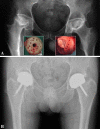Hip resurfacing results for osteonecrosis are as good as for other etiologies at 2 to 12 years
- PMID: 19756906
- PMCID: PMC2806980
- DOI: 10.1007/s11999-009-1077-2
Hip resurfacing results for osteonecrosis are as good as for other etiologies at 2 to 12 years
Abstract
A bone-conserving prosthetic solution, such as hip resurfacing arthroplasty, is desirable for patients with osteonecrosis (ON) of the femoral head because of their young age. However, many surgeons are reluctant to perform hip resurfacing for ON because of large femoral head defects. To ascertain whether this reluctance is warranted, we determined the mid- to long-term effects of ON on the survivorship, radiographic implant fixation, and disease-specific and quality-of-life scores of hip resurfacing. We compared the results of metal-on-metal resurfacing performed for ON of the hip (including large lesions) with those of resurfacing performed for other causes. The ON group had 70 patients (85 hips) and the control group 768 patients (915 hips) including all other etiologies operated on during the same period. The ON group was younger and had a greater incidence of femoral defects, a smaller component size, and a lower body mass index, three variables previously shown to reduce survivorship in hip resurfacing. We observed no difference in survivorship between the ON group and the control group even after adjusting for head size, body mass index, and defect size. Pain relief, walking, and function scores were comparable postoperatively. The activity level was lower in the ON group. Our data suggest ON is not a contraindication for resurfacing even with large femoral head defects.
Level of evidence: Level III, therapeutic study. See Guidelines for Authors for a complete description of levels of evidence.
Figures



Similar articles
-
Metal-on-metal hip resurfacing in patients younger than 50 years: a retrospective analysis : 1285 cases, 12-year survivorship.J Orthop Surg Res. 2017 Jun 2;12(1):79. doi: 10.1186/s13018-017-0579-y. J Orthop Surg Res. 2017. PMID: 28578684 Free PMC article. Review.
-
Frequent femoral neck osteolysis with Birmingham mid-head resection resurfacing arthroplasty in young patients.Clin Orthop Relat Res. 2015 Dec;473(12):3770-8. doi: 10.1007/s11999-015-4348-0. Clin Orthop Relat Res. 2015. PMID: 25981716 Free PMC article.
-
Use of metal-on-metal total hip resurfacing for the treatment of osteonecrosis of the femoral head.J Bone Joint Surg Am. 2006 Nov;88 Suppl 3:90-7. doi: 10.2106/JBJS.F.00543. J Bone Joint Surg Am. 2006. PMID: 17079373
-
Clinical and radiographic results of metal-on-metal hip resurfacing with a minimum ten-year follow-up.J Bone Joint Surg Am. 2010 Nov 17;92(16):2663-71. doi: 10.2106/JBJS.I.01715. J Bone Joint Surg Am. 2010. PMID: 21084576
-
Resurfacing arthroplasty in osteonecrosis of the hip.Orthop Clin North Am. 2005 Apr;36(2):231-42, x. doi: 10.1016/j.ocl.2005.02.005. Orthop Clin North Am. 2005. PMID: 15833461 Review.
Cited by
-
Metal-on-metal hip resurfacing arthroplasty: an analysis of safety and revision rates.Ont Health Technol Assess Ser. 2012;12(19):1-63. Epub 2012 Aug 1. Ont Health Technol Assess Ser. 2012. PMID: 23074429 Free PMC article. Review.
-
Long-term results of Birmingham hip resurfacing arthroplasty in Asian patients.J Artif Organs. 2018 Mar;21(1):117-123. doi: 10.1007/s10047-017-0981-6. Epub 2017 Aug 30. J Artif Organs. 2018. PMID: 28856453
-
Does the extent of osteonecrosis affect the survival of hip resurfacing?Clin Orthop Relat Res. 2013 Jun;471(6):1926-34. doi: 10.1007/s11999-013-2833-x. Epub 2013 Feb 9. Clin Orthop Relat Res. 2013. PMID: 23397316 Free PMC article.
-
Total hip arthroplasty in advanced osteonecrosis: the short-term results by metal-on-metal hip resurfacing.Med Sci Monit. 2011 Feb;17(2):CR78-82. doi: 10.12659/msm.881391. Med Sci Monit. 2011. PMID: 21278692 Free PMC article.
-
Metal-on-metal hip resurfacing in patients younger than 50 years: a retrospective analysis : 1285 cases, 12-year survivorship.J Orthop Surg Res. 2017 Jun 2;12(1):79. doi: 10.1186/s13018-017-0579-y. J Orthop Surg Res. 2017. PMID: 28578684 Free PMC article. Review.
References
-
- Amstutz H. The future of hip resurfacing. In: Amstutz HC, editor. Hip Resurfacing: Principles, Indications, Technique and Results. Philadelphia, PA: Elsevier; 2008. pp. 253–254.
-
- Amstutz H. Surgical technique. In: Amstutz HC, editor. Hip Resurfacing: Principles, Indications, Technique and Results. Philadelphia, PA: Elsevier; 2008. pp. 77–94.
-
- Amstutz H, Beaulé P, Dorey F, Duff M, Campbell P, Gruen T. Metal-on-metal hybrid surface arthroplasty: two to six-year follow-up study. J Bone Joint Surg Am. 2004;86:28–39. - PubMed
Publication types
MeSH terms
Substances
LinkOut - more resources
Full Text Sources
Medical
Research Materials
Miscellaneous

